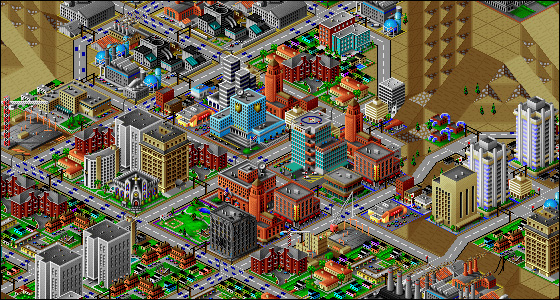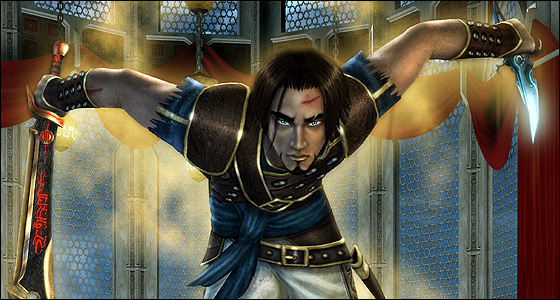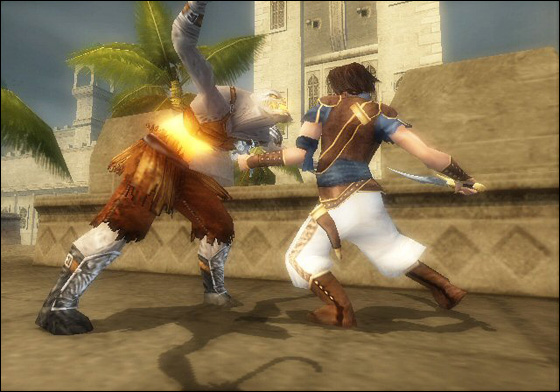Global Markets as The Next Casual Gaming-sized Phenomena
September 7th, 2009
 (This is another canned GameSetWatch column, I hope you enjoy.)
(This is another canned GameSetWatch column, I hope you enjoy.)
If 10 year product life cycles are anything to go by, then we’re perhaps a third of the way through this most recent generation of consoles. Over the past several years we’ve seen an unprecedented turning point for the industry in the form of audience expansion through the advent of casual gaming. While casual gaming will no doubt continue to embed itself as a norm of this industry, enjoying the many fruits of its labours, we can already see the swell forming for the next phenomena to succeed casual gaming and that is expansion to global audiences.
The Global Medium
Video games are hardly a global medium. Japan, America and “Europe” (includes Australia and New Zealand); the three regions where video games are most prominent in terms of shared distribution, only account for roughly 20% of the global population. Even between these divisions there remains a large disparity in available software. As an Australian player I cannot legitimately purchase PSone classics such as Metal Gear Solid, Resident Evil or Spyro the Dragon through the Playstation Network. As an American player, perhaps you don’t know very much about the classic Enix RPG Terrinigma? Nay we dare discuss Japan.
The other collective 70-80% of global population have their own individual market situations. Often the means to acquire games in such regions are more complex (although not necessarily illegal, as one might assume), shifting the market in multiple, intertwining ways. Despite the natural complications, games are often no less prominent and successful in such countries, even though software distribution is rather limited, particularly of the home consoles.
So then; the Difference
What separates a China, Korea or India from becoming a Japan, America or Europe in many cases is systems of trade and systems of localization which are much narrower. Although there is a degree of generalization (comes with the territory) the 70-80% figure can be divided into two groups which I have suitably dubbed “enclosed markets” and “one-way street markets”.

China and Korea (both separate and as a joint unity) represent the former (“enclosed markets”) very well. Both countries enjoy rich game industries which can be segregated in several components; the burgeoning development industry from the mainland, rampid piracy and importation of mostly western or Japanese product from neighbouring areas (ie. Hong Kong, Taiwan) and legal consoles and software (ie. iQue, DS Lite, Wii(Korea only)). The legal, mostly online-based industry lives off the pay-per-play/pay-for-necessity model and is a thriving market. With all of the illegal stuff being detached from the mainland (ie. most of what is pirated isn’t legally available anyways) and everything legal predominately existing only in China or Korea, the Chinese and Korean games markets are in this case self-sustaining.
Unlike the enclosed markets, many of the countries that would fall into the “one-way street market” category have little or no industry of their own. Whatever industry is present usually develops for the web. Common sense given development kits are tough to come by. Jamaica embodies these characteristics. As such, there is no recognised games industry in Jamaica and local distribution is either weak or non-existent. Never ones to let down though, keen Jamaican gamers import their games and consoles either from local import vendors or through the internet. Further, enthusiastic players and community leaders in the capital Kingston will pool together their resources to form community “arcades”. In these “arcades” players can pay to play the latest games, only a couple of months (or less) after the North American street dates. So, in contrast, one-way street markets have relatively small industries of their own and rely wholly on distribution from the outside.
Fixing This “Problem”
Everything I’ve just explained shouldn’t be treated as a “problem” or “issue”, because the reality is that there will never be such a thing as a “total” global market, and nor should we believe otherwise. Games are simply product after all, and product regulation varies per country, per culture. Games are also very subjective things and as people who live in culture which shapes our sensibilities, not every game is suitable for every market or every person. The success of Madden in the UK and Australia is indicative enough of that!
Instead, it’s all about access and distribution. There’s nothing that says players in Russia pirate video games simply because they’re Russian. Rather, there is no distribution model in place which satisfies the perception of value for Russian players. Further, illegal means can give access to certain content, but not all of it. If you provide people with a reasonable deal, there’s no reason for them to turn it down. The reasonable deal obviously must adhere to the cultural norms of the respective societies which is what will shape the consideration sets of the publishers of today and the future.
Old News
Reading this far you might be forgiven into thinking this is all rather current, which is to say that it isn’t! Global expansion is old news and has been quietly developing since the start of the industry. The same countries listed as examples were acquiring games, just as they do now, 15-20 years ago through similar, if not the same means. With this said though the industry is now the largest of all forms of entertainment and distribution continues to lose physicality, ensuring that major strides are all but imminent. The following initiatives are good examples of this;
In April Sony announced that it would be releasing six to seven new titles developed specially for an Indian market in partnership with local developers. On May 25th, Brazil released their own home console Zeebo, created for developing counties and soon to be exported elsewhere. Back in 2006 Nintendo opened a new Korean subsidiary with the DS Lite and Wii releasing in the respective years that followed – both consoles have seen significant success since.
Wishful Thinking?
There are two key factors that are and will continue to affect the global expansion of the video game industry in forthcoming decades. Those being the newfound modernization of countries such as China and India and the continual success and pervasiveness of the video game industry.
As suggested, the internet is a major contributor to the latter. Physical distribution, shipping and additional expenditure that comes with it can be completely avoided through distribution platforms which run over the internet. Every country that is able, already acquires games through the internet, so for publishers it’s only a matter of value proposition. The same can be said for development; the internet creates a viable market place for developers such as the few in Jamaica.
The tools are therefore already in place, with further advancements (such as streaming gameplay) on their way. The key problem then is having someone set up a system of access which provides attractive content at a good price point through a viable means. It’s not particularly easy to do in an industry with multiple consoles, established distribution streams and individual markets, but it’s worth considering. At least, that’s my prediction of where global distribution is heading.
Balancing Western and Middle Eastern Cultures in Prince of Persia: Sands of Time
September 2nd, 2009

(This is a canned GameSetWatch column. You might notice that I’ve moved from the biweekly format. I hope you enjoy.)
Middle Eastern folk tales have for centuries held a prominent place in the world’s rich thematic of story telling. The earlier stories began their lives existing within the fragility of spoken language. If a story could garnered enough interest within a community it would spread with a pervasive force to neighbouring communities, hoping from township to township. Each step would see the tale take on new forms as cultural influences push and pull various plot points. One Thousand and One Nights is a prime example of such a story, a culmination of Arabic, Persian, Indian and Egyptian traditions and beliefs all rolled into the one collection of fables.
Print would soon come to immortalize these stories and with cross national trade taking place it wouldn’t be long before what originated as a series of stories spread among a few townships became a larger part of the world’s global culture. These stories, now translated, compiled into books and distributed globally would become the foundation for western adaptions into film and then animation. Arabian Nights (1942) The Seventh Voyage of Sinbad (1958) and Aladdin (1992) represent some of the most significant western adaptions of prominent Middle Eastern folk tales. In this industry though, we have Prince of Persia, a game which I would argue has an elusive purity in large part due to the rich palette it draws from.
When creating a piece of media derived from such a rich cultural background it’s important to find a comfortable middle ground which both respects the source culture and the intended audience. After all, you want the audience to enjoy the media, yet at the same time your inspiration contains the beliefs and ideologies of other people, you’d be a criminal to trample all over that by misrepresenting their values.
The Prince of Persia series does partake in its fair share of trampling and a fair share positive representation too. Context is also important, so I say it’s well worth having a look at how Prince of Persia: Sands of Time (it’s my favourite) balances either end.

(The texts are symbolic of the culture, therefore I should clarify by saying that it’s not so important that the new piece of media abides by the original text as so much as to be respectful of intents and cultural differences.)
Generally speaking, Sands of Time is similar to many modern films inspired by the Middle East. Sands of Time is an innocent stab at a popular theme mixed with western ideals and influence. Just like other western attempts it very much takes the extremely oriental perspective, treating the subject matter as the weird and wonderful, yet never quite normal — like us. There’s always a distance to be drawn. The narrative, characters and setting are therefore all set within the appropriate cultural context of western expectations and there’s nothing too culturally offensive so to speak. It might be clichéd but even in this sense, the game deserves major kudos for at least not misrepresenting the culture in this post 9/11 world. Clearly the game was made with good if not a little characterized intent.
My presumption here is that by setting the game and its cast somewhere in the past all is seen as okay since after all Middle Eastern people weren’t really all that bad back then, they’re just not very good now. Taking the safe path through Persian history allows Ubisoft to avoid dealing with the aforementioned stereotypes that westerners hold against the contemporary Middle East. The game can never put modern Middle Eastern people and positive attributes in the same pool. The characters very much reflect this attitude by firmly planting themselves as traditional. If we extend our scope a little into the latest incarnation of the series we can see a contradiction in how the heavily western Prince of Persia (2008) protagonists are designed as people with modern day sensibilities, yet the Middle Eastern folk are reserved to the safe archetype of being traditional. If they’re traditional they’re even less like us and therefore that’s okay. Alas, I digress, let’s stay focused on the characters though.
Characters are very important to this conversation as they’re role models of their culture. As with the game in general, the Prince conforms to typically western tropes, maintaining enough Persian influence through appearance and accent to justify his title of Persian descent. As a partly western character he plays the role of the masculine hero in pursuit of the buxom babe – and yes the babe is suitably buxom. His warrior’s attire very much highlights this, making him ever more masculine as he loses various pieces of his clothing. There’s both quality and detriment to this approach. Portraying the somewhat Middle Eastern protagonist as a competent, albeit western, hero is no doubt positive, yet doing so by means which suppress the Middle Eastern culture is itself misleading. An ideal means would be to depict the Prince’s gradual maturation through a Middle Eastern lens by their own perceptions of heroism. This itself though is difficult within a western context, hence the foregrounded western ideologies can be forgiven as the acceptable norm.

What cannot be forgiven though is how the most Middle Eastern appearing characters in the game; the sand creatures, are depicted as barbaric and dangerous. Most of the monsters are also significantly disfigured and equipped with privative weapons as well. Of course, they’re enemies, fodder for the Prince’s blade, they should look menacing and evil. Wrapping them up in turbans, vests and traditional garbs, and layering them with a grey skin colour and possessed eyes only appeals to our underlying racist sensibilities. Ironically, the Prince’s father in which the Prince must slay early on is the most dressed up of them all.
I’ve been rather critical so far of what is for the most part standard fair in the entertainment business, so let’s look at some of the better representations. Throughout the whole trilogy the importance of water is implicitly stressed through it’s symbolism of life. The Prince drinks water to heal and save, often having to go for multiple drinks to fully refill his health bar. Sand, through the sands of time and sand creatures may also be an opposing metaphor for death.
The game also acknowledges the early conflict between India and neighbouring countries, often referencing names within the real life setting. Furthermore the narrative frequently uses terms of Indian and Muslim hierarchy such as Maharajah and Vizier. Arabic is also encrusted on the Prince’s sword.
Conclusion
The underlying connotations of Sands of Time inherently underpin typically western ideas and norms. Yet Sands of Time‘s acknowledgement and mostly positive representation of the Middle East, while flawed, should not be understated. It’s a typical byproduct of dominant western ideologies, conforming to similarly misguided adaptions which created the precedence for Prince of Persia’s overall theme. This much is to be expected though, we see the world through our own cultural lens and our entertainment is nothing more than a reflection of that.
Majora’s Mask And Cultural Alienation
August 26th, 2009
I’ve been working on an upcoming column on cultural difference and initially wrote up the following two paragraphs which as you’ll notice are instead about cultural alienation in Zelda Majora’s Mask. It’s largely irrelevant to what I want to say in the piece, but I’m super pleased with it anyways and couldn’t bare to scrap it. Honestly, I wish I could do a thesis on this game or something.
“I’ve referenced Zelda: Majora’s Mask twice before in this column, because it beautifully captures the feeling of cultural isolation and difference. We have a series of expectations about how the world works, this can be called our cultural understanding of the world. When we exist in a foreign culture, that understanding can be subverted by the immediate culture surrounding us. We might speak a language which isn’t our’s to people who perhaps aren’t quite like us – things are naturally going to be different. Hence when integrating into a new cultural environment the feeling of alienation often arises. You might call it culture shock, I guess.
Majora’s Mask elicits this uncomfortable feeling very distinctively by almost immediately severing ties with player’s expectations of a Zelda game. Just as one’s cultural understanding is quickly subverted in a foreign context, Nintendo destroy all player expectation’s, casting you off as a lowly Deku Scrub. And people don’t like you. In fact, you’re without justification blown off, frowned upon by members of Clock Town – even the town dog aspires for your demise.”



 Game Design Companion: A Critical Analysis of Wario Land 4 - $7.99
Game Design Companion: A Critical Analysis of Wario Land 4 - $7.99 Level Design: Processes and Experiences
Level Design: Processes and Experiences Speed Boost: The Hidden Secrets Behind Arcade Racing Design - $5.99
Speed Boost: The Hidden Secrets Behind Arcade Racing Design - $5.99 Adventures in Games Analysis: Volume I - $5.99
Adventures in Games Analysis: Volume I - $5.99







